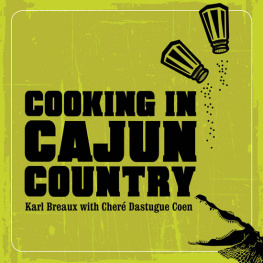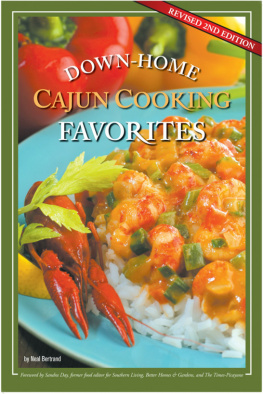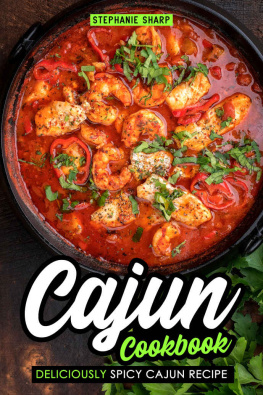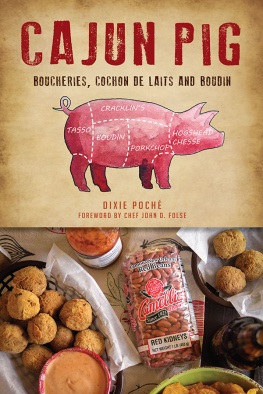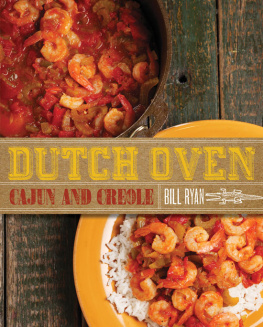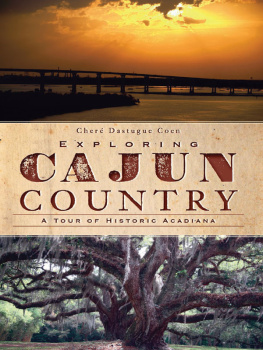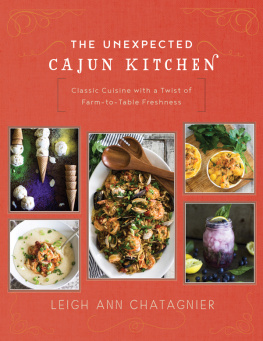Breaux Karl - Cooking in Cajun Country
Here you can read online Breaux Karl - Cooking in Cajun Country full text of the book (entire story) in english for free. Download pdf and epub, get meaning, cover and reviews about this ebook. City: Salt Lake City, year: 2009, publisher: Gibbs Smith, genre: Home and family. Description of the work, (preface) as well as reviews are available. Best literature library LitArk.com created for fans of good reading and offers a wide selection of genres:
Romance novel
Science fiction
Adventure
Detective
Science
History
Home and family
Prose
Art
Politics
Computer
Non-fiction
Religion
Business
Children
Humor
Choose a favorite category and find really read worthwhile books. Enjoy immersion in the world of imagination, feel the emotions of the characters or learn something new for yourself, make an fascinating discovery.
- Book:Cooking in Cajun Country
- Author:
- Publisher:Gibbs Smith
- Genre:
- Year:2009
- City:Salt Lake City
- Rating:5 / 5
- Favourites:Add to favourites
- Your mark:
- 100
- 1
- 2
- 3
- 4
- 5
Cooking in Cajun Country: summary, description and annotation
We offer to read an annotation, description, summary or preface (depends on what the author of the book "Cooking in Cajun Country" wrote himself). If you haven't found the necessary information about the book — write in the comments, we will try to find it.
Cooking in Cajun Country — read online for free the complete book (whole text) full work
Below is the text of the book, divided by pages. System saving the place of the last page read, allows you to conveniently read the book "Cooking in Cajun Country" online for free, without having to search again every time where you left off. Put a bookmark, and you can go to the page where you finished reading at any time.
Font size:
Interval:
Bookmark:

Cooking in Cajun Country
Digital Edition v1.0
Text 2009 Karl Breaux with Cher Dastugue Coen
All rights reserved. No part of this book may be reproduced by any means whatsoever without written permission from the publisher, except brief portions quoted for purpose of review.
Gibbs Smith, Publisher
PO Box 667
Layton, UT 84041
Orders: 1.800.835.4993
www.gibbs-smith.com
ISBN: 978-1-4236-1246-9
This book is for my Acadian ancestors who not only survived, but thrived after the near annihilation from the great Diaspora of 1755. The Cajun people were granted a new homeland by the Spanish Crown in the form of land grants and a few head of cattle in order to seed Spanish Louisiana with Catholics. The Native American inhabi-tants of the area helped us by sharing their knowledge of food gathering and natural medicines in this strange new land. The blending of the different cultures that came to Louisiana such as the African, Italian, Lebanese, Sicilian, Creole French, and others created a culinary gestalt of worldwide acclaim.
I thank God that we have managed to preserve our unique culture and French language. May you enjoy the authentic Cajun recipes in this book. Love everybody and have fun, life is short!
Karl Breaux, a.k.a. Cajun Karl
To Joyce and Penny Dastugue, thanks for the amazing culinary memories.
Cher Dastugue Coen
Flavor is a word that pops up frequently when anyone talks about South Louisiana. We have a special flavor in our lifestyle, our music, and even our politics.
But nowhere is the flavor more apparent or more piquante than in the aroma and delicacies that come from the big black iron pots used to simmer and slow cook our traditional foods.
South Louisiana has become justly famous for its Cajun cooking, stirred by Cajun people named Breaux and their kin, but what we call Cajun cooking has roots that predate the arrival of the Acadians in Louisiana. Native Americans and Creoles had an early influence on South Louisiana cooking, introducing ingredients and cooking methods that Cajuns never knew about.
A migration of tens of thousands of people from the West Indies added something new to the pot. So did Spanish, Irish, German, and Italian, and many other cooks who discovered that we can grow delectable fresh herbs alongside the vegetables in our gardens; that there is a natural plenty of crabs, shrimp, and fin fish in our rivers and bayous and the nearby Gulf of Mexico; that the game from our woodlands and wetlands can be cooked up in sauce piquantes and touffes that have become standard items on our tables. All have contributed a soupon of this and a pinch of that to the dishes of today.
In many instances, what the world knows as Cajun cooking is something that my Landry and Babin and Vincent grandmothers would never recognize. (Indeed, I once pointed out to Paul Prudhomme, creator of the world-famous blackened redfish dish, that when my grandmother burned the fish, she threw it out.)
But there remain basic ingredients that are necessary for a dish to pass the testthe holy trinity of green bell pepper, garlic, and onions, of course, but including some not so tangible ones, such as the patience to properly make a roux or cook on a low and slow fire long enough to bring out every ounce of flavor in a dish.
And that list includes, especially, the ability to season things just so. I dont know where or how the idea got started that South Louisiana food has to be laced with hot sauce or cayenne pepper that you can barely eat it or taste anything else. Our food is spicy, it is well seasoned, but the heat comes from the cook stove, not from the sauce.
Its that ability to taste a dish, know whats missing and how much of it, and add it to the dish at just the right time that makes all the difference in the world.
Theres more to it than mixing the ingredients in a big iron pot with a long wooden spoon. But if you follow these recipes carefully and take your time in doing it, even an amateur can learn to cook so well that just the aroma will cause people to stop in the kitchen, savor the odors, and exclaim, Mais l!
Jim Bradshaw, Cajun historian and author
Travel through South Louisiana and youll quickly learn that Cajun cooking is more than a heavy dose of black pepper, a splash of tangy hot sauce, or a fancy name to a fast food creation. In fact, much of what the country enjoys as Cajun might be as foreign to Louisiana as a snowstorm. Not to mention its much more delicious.
Cajun cuisine has evolved drastically since the Acadians left the west coast of France for Canada, changing as its people were exiled and relocated to Louisiana, then altered even more when they came in contact with the colonys Spanish, German, Italian, and other nationalities and adopting to the deltas agriculture and livestock. Even in the Cajun heartland of Louisiana, an area that stretches from Mississippi to Texas and incorporates twenty-two parishes (counties), the cuisine differs from region to region.
Cajun Karl Breaux, whose family hails back more than two hundred years in South Louisiana, will quickly tell you that nothing goes to waste in a Cajun household, how living off the land was integral to the culture, and how even a day trip out to the camp or houseboat can revive an urban soul. And that from the Mississippi state line to the Sabine River fronting Texas, from the Gulf of Mexico to dead center of the state, Cajuns cook up delectable food in a wide variety of ways.
In this cookbook, Breaux explains the nuances of oyster harvesting in the southeast bayous and the communal tradition of la boucherie, or hog butchering, in the upper prairies. He shows how some areas prefer their gumbos light with seafood while others choose a darker roux with wild game and sausage. Alligator sauce piquante is a favorite along the bayous and marshes while rice dishes dominate the southwest, where crawfish and rice are grown in alternating seasons. Crawfish, although consumed statewide, takes on an almost religious significance in Lafayette and surrounding areas, which is why the town of Breaux Bridge is considered the Crawfish Capital of the World.
Go hunting and fishing with Breaux, wholl share stories as old as the people, and youll learn why certain foods are so culturally vital to authentic Cajun cooking. Then try them out for yourself.
We hope you enjoy these recipes at home, but please, come visit. The next best thing to reading about Cajun Country and cooking up a gumbo on a chilly fall evening is sampling this unique American cuisine first hand. Well leave a space at the table.
Before the founding of Jamestown, a group of French pioneers crossed the Atlantic Ocean to settle in what is now the Maritimes region of Canada. Most of their settlements were in Nova Scotia, but some ventured into Prince Edward Island and upper New Brunswick. Because of the massive tides in the Bay of Fundy, these French settlers established fertile farmland by creating an elaborate system of dykes that held back the sea. They called their land Acadie, or Acadia.
Over the years these Acadians developed a colonial way of life that defined them in language, music, farming, and cuisine. They lived peacefully with the neighboring Indians and rarely participated in the wars between England and France, which had spread into the New World.
Acadie passed back and forth from France to England until the British fully conquered the area in the eighteenth century. The English allowed the Acadians to remain on their land but made demands on their language and Catholic religion, which the Acadians either ignored or attempted to alter through negotiations. Despite being peaceful citizens, the Acadians lived and farmed the richest land in the region and outnumbered the English and were thus viewed as a threat.
Font size:
Interval:
Bookmark:
Similar books «Cooking in Cajun Country»
Look at similar books to Cooking in Cajun Country. We have selected literature similar in name and meaning in the hope of providing readers with more options to find new, interesting, not yet read works.
Discussion, reviews of the book Cooking in Cajun Country and just readers' own opinions. Leave your comments, write what you think about the work, its meaning or the main characters. Specify what exactly you liked and what you didn't like, and why you think so.

